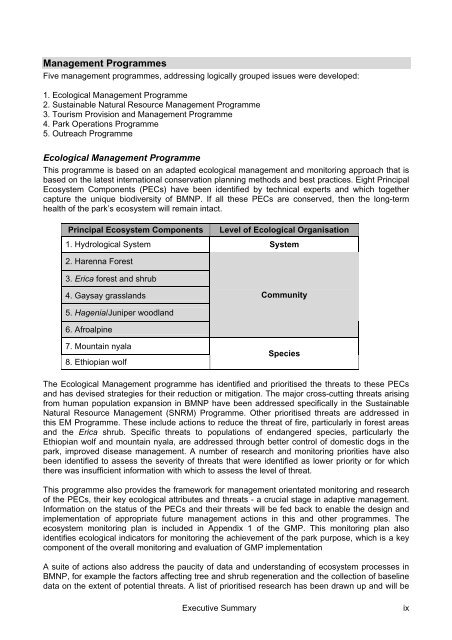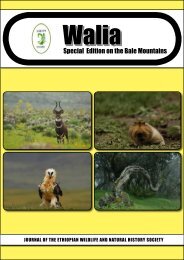Bale Mountains National Park - Zoologische Gesellschaft Frankfurt
Bale Mountains National Park - Zoologische Gesellschaft Frankfurt
Bale Mountains National Park - Zoologische Gesellschaft Frankfurt
You also want an ePaper? Increase the reach of your titles
YUMPU automatically turns print PDFs into web optimized ePapers that Google loves.
Management Programmes<br />
Five management programmes, addressing logically grouped issues were developed:<br />
1. Ecological Management Programme<br />
2. Sustainable Natural Resource Management Programme<br />
3. Tourism Provision and Management Programme<br />
4. <strong>Park</strong> Operations Programme<br />
5. Outreach Programme<br />
Ecological Management Programme<br />
This programme is based on an adapted ecological management and monitoring approach that is<br />
based on the latest international conservation planning methods and best practices. Eight Principal<br />
Ecosystem Components (PECs) have been identified by technical experts and which together<br />
capture the unique biodiversity of BMNP. If all these PECs are conserved, then the long-term<br />
health of the park’s ecosystem will remain intact.<br />
Principal Ecosystem Components Level of Ecological Organisation<br />
1. Hydrological System System<br />
2. Harenna Forest<br />
3. Erica forest and shrub<br />
4. Gaysay grasslands<br />
5. Hagenia/Juniper woodland<br />
6. Afroalpine<br />
7. Mountain nyala<br />
8. Ethiopian wolf<br />
Community<br />
Species<br />
The Ecological Management programme has identified and prioritised the threats to these PECs<br />
and has devised strategies for their reduction or mitigation. The major cross-cutting threats arising<br />
from human population expansion in BMNP have been addressed specifically in the Sustainable<br />
Natural Resource Management (SNRM) Programme. Other prioritised threats are addressed in<br />
this EM Programme. These include actions to reduce the threat of fire, particularly in forest areas<br />
and the Erica shrub. Specific threats to populations of endangered species, particularly the<br />
Ethiopian wolf and mountain nyala, are addressed through better control of domestic dogs in the<br />
park, improved disease management. A number of research and monitoring priorities have also<br />
been identified to assess the severity of threats that were identified as lower priority or for which<br />
there was insufficient information with which to assess the level of threat.<br />
This programme also provides the framework for management orientated monitoring and research<br />
of the PECs, their key ecological attributes and threats - a crucial stage in adaptive management.<br />
Information on the status of the PECs and their threats will be fed back to enable the design and<br />
implementation of appropriate future management actions in this and other programmes. The<br />
ecosystem monitoring plan is included in Appendix 1 of the GMP. This monitoring plan also<br />
identifies ecological indicators for monitoring the achievement of the park purpose, which is a key<br />
component of the overall monitoring and evaluation of GMP implementation<br />
A suite of actions also address the paucity of data and understanding of ecosystem processes in<br />
BMNP, for example the factors affecting tree and shrub regeneration and the collection of baseline<br />
data on the extent of potential threats. A list of prioritised research has been drawn up and will be<br />
Executive Summary ix
















